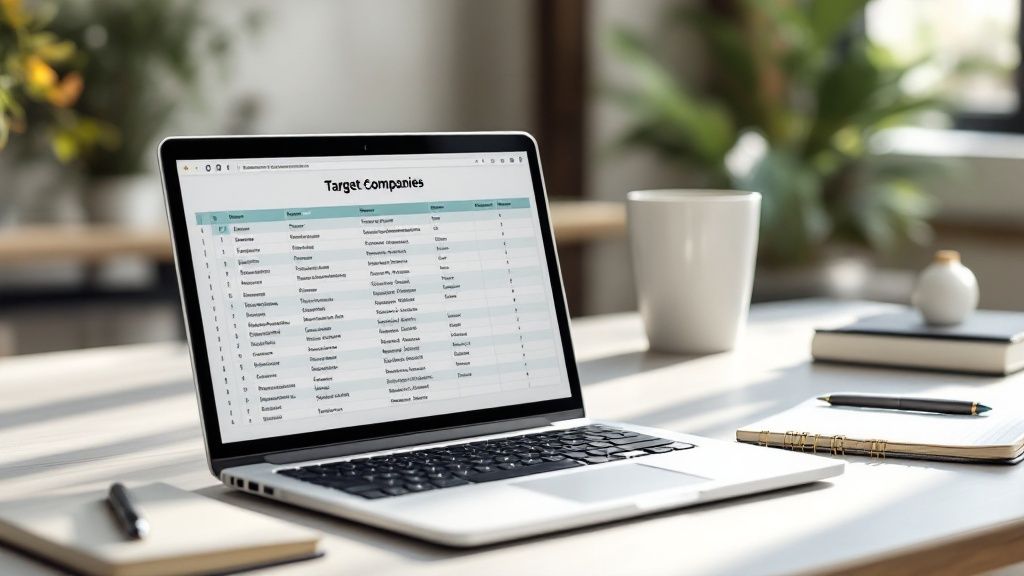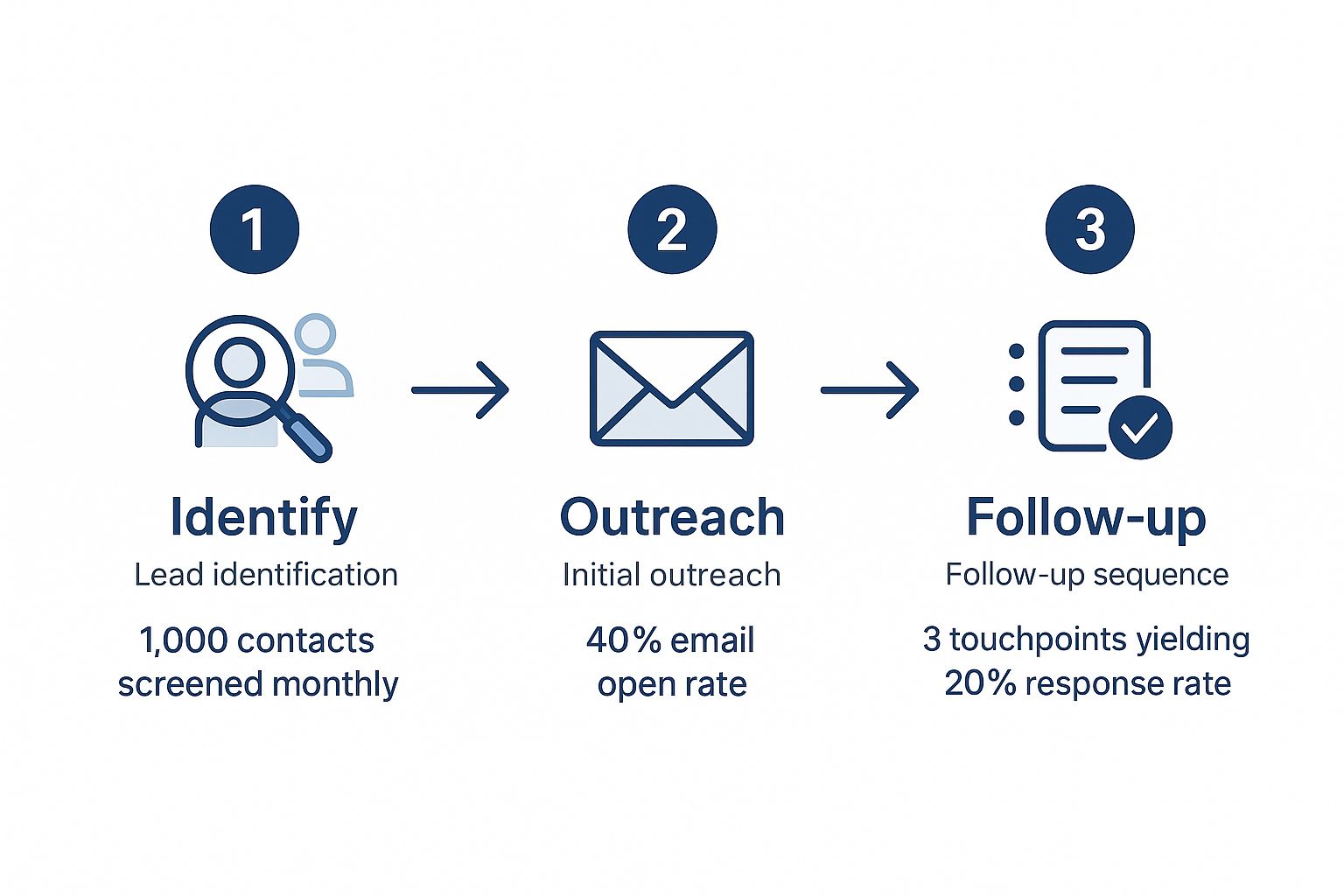Mastering the B2B Sales Funnel for Predictable Growth
A practical guide to the B2B sales funnel. Learn to build, measure, and optimize your funnel with proven strategies for converting leads into...
Discover proven B2B prospecting strategies that build pipeline and drive sales. Learn how to find high-value leads and master modern outreach.
TL;DR: Forget casting a wide net. Modern B2B prospecting is all about precision—building a razor-sharp Ideal Customer Profile (ICP) and hitting the right decision-makers with a strategic, multi-channel outreach that delivers real value from the first touchpoint.

Think of effective B2B prospecting as the engine that drives your entire sales process. It's moved way beyond just cold calling or blasting out generic emails. Today's top performers are the ones who combine deep research, genuine personalization, and a coordinated outreach strategy that plays out across multiple channels.
The absolute first step, and it's non-negotiable, is nailing down a detailed Ideal Customer Profile. This makes sure you're not just finding leads, but finding the right leads.
From there, it's all about delivering value from the very first touchpoint. This guide is the practical playbook you need to turn this modern approach into a predictable revenue machine.
If you think B2B prospecting is still about hammering the phones or blasting out generic emails, it's time for a reality check. The old playbook is retired. Today, winning at prospecting is a different game—one that requires deep research, genuine personalization, and a smart, coordinated approach across multiple channels.
This isn't about finding any contact. It's about pinpointing the exact individuals within the right companies who need what you sell. The mission is to trade your wide, inefficient net for a sharp, precise spear aimed directly at prospects who fit your Ideal Customer Profile (ICP). Getting this right from the start means every ounce of effort is spent on deals that have a real chance to close.
The core mindset shift is from "selling to" a prospect to "solving for" them. Value isn't a future promise; it's what you deliver from the very first touchpoint.
Let's face it: the modern B2B buyer is smarter and more self-reliant than ever. The global B2B eCommerce market is on track to hit a staggering $32.11 trillion in 2025, and digital channels already drive 56% of B2B revenue in the US.
What does that mean for you? Buyers are doing their homework on their own. In fact, a whopping 83% now prefer to place orders themselves online. This isn't just a trend; it's a fundamental shift. For a deeper dive into digital outreach, check out these strategies on how to generate leads online.
Because buyers are so self-directed, your outreach has to be exceptionally relevant to get noticed. You're no longer interrupting their day; you're aiming to become a valuable part of their research process by showing up with insights they haven't found on their own.
This graphic from Salesforce drives home the key differences between B2B and B2C sales.

Note the emphasis on longer sales cycles and the need to convince multiple decision-makers—both defining features of the B2B world.
It's easy to lump "prospecting" and "lead generation" together, but they're two different beasts. While both feed the top of your funnel, they come from different directions.
Think of it this way:
Lead generation casts a wide net. Prospecting is a targeted hunt. To build a predictable pipeline, you need both working in harmony.

Great B2B prospecting doesn't start with a cold email. It starts with a critical question: who are you actually selling to? If you can't answer that with certainty, you're just taking shots in the dark and wasting time on companies that were never going to buy.
This is where your Ideal Customer Profile (ICP) comes in. It's a detailed blueprint of the perfect company for your solution. A solid ICP transforms prospecting from a scattered, hope-based activity into a precise, targeted mission. It's the difference between blindly casting a net and using a laser-guided spear.
The goal is simple: focus your energy on the accounts most likely to close—and close big.
When most people hear "ICP," they think of basics: company size, industry, location, and revenue. These firmographics are a decent starting point, but they barely scratch the surface. They tell you what a company is, not why they'd be a great fit for you.
To build an ICP that actually drives pipeline, you have to dig deeper into data that tells a story. We're talking about understanding the context, behavior, and intent that signal a real opportunity.
Here's where to shift your focus:
A truly effective ICP isn't a static document. It's a living profile that gets smarter as you gather more data. It's your strategic filter for everything you do.
Where do you get this data? Your best source is already in your CRM: your current, happiest customers. The companies that saw value fast, stick around, and expanded their contracts hold the clues to what a "perfect fit" looks like.
Start by interviewing your top 10 customers. Ask about the problems they had before they found you, what their decision-making process looked like, and the results they've seen.
As you collect this info, look for common threads.
These patterns are gold. They turn your ICP from a guess into a data-backed tool that points you straight to your next best customer. For a deeper look, our ultimate account research checklist gives you a step-by-step framework.
When you combine firmographics with technographics and real-world buying signals, you create a multi-dimensional profile. This gives you the power to prioritize your outreach with incredible accuracy.
Relying on a single channel for B2B prospecting is like trying to build a house with only a hammer. To break through the noise, you need a coordinated, multi-channel approach that surrounds your prospects with value, not just a barrage of messages.
The goal isn’t to be everywhere at once. It’s about being in the right place at the right time with the right message.
This means moving beyond isolated email blasts or a list of cold calls. An effective strategy weaves together the strengths of email, phone, and social platforms like LinkedIn into a single, cohesive sequence. Each channel builds on the last, creating a narrative that feels helpful and familiar.
This infographic shows what that flow looks like in practice, visualizing how contacts are narrowed down through successive touchpoints to generate a response.

The data is clear: persistence pays off. It's the multiple touchpoints across a well-planned sequence that drive real engagement.
The magic of multi-channel outreach is in the synergy between your touchpoints. Don't think of each channel as a separate task; see them as connected steps in one conversation. Your prospect should feel a sense of progression, not just a series of random pings.
A successful sequence might look like this:
The key is to make every touchpoint feel like a natural next step in an ongoing dialogue. You're not just a salesperson; you're a helpful guide.
To help you decide which channels to prioritize, this table breaks down the most common options.
This table compares the primary B2B prospecting channels, outlining their best use cases, key advantages, and potential challenges to help you build a balanced outreach strategy.
| Channel | Best Use Case | Key Advantage | Potential Challenge |
|---|---|---|---|
| Delivering detailed, value-packed content like case studies or whitepapers. | Scalable, asynchronous, allows for rich content and easy tracking. | Low open rates, inbox clutter, can feel impersonal without customization. | |
| Phone | Qualifying leads, handling complex questions, building genuine human connection. | Immediate feedback, high-impact personalization, direct conversation. | Can be intrusive, requires significant time, high rejection rate. |
| Initial research, relationship building, and warming up cold leads before direct outreach. | Professional context, access to prospect's network and activity, less intrusive than a cold call. | Connection request fatigue, requires consistent engagement to be effective. | |
| Direct Mail | High-value accounts, cutting through digital noise with a memorable, physical touchpoint. | High open rates (it's physical mail!), stands out, feels premium and personalized. | Expensive, difficult to scale, hard to track direct ROI. |
A balanced strategy involves a mix of these channels, each playing a specific role in your outreach sequence.
While digital channels are essential, don't sleep on the phone. Cold calling is still an effective tool when used correctly. An analysis of over 204,000 cold calls revealed that connecting with a lead takes an average of three attempts, and the success rate for starting a conversation is 65.6%.
With an average call duration of 93 seconds, these interactions are quick, direct, and can slice through digital clutter. The phone is your best tool for creating a human connection and reacting in real-time to a prospect's tone and concerns. For a closer look, you can learn how to effectively conduct cold outreach.
Your outreach messages must be laser-focused on the prospect's world, not yours. Generic templates get deleted. Your goal is to be hyper-relevant and genuinely helpful from the first sentence.
Here are a few tips for messages that get replies:
By combining strategic sequencing with empathetic, value-driven messaging, your B2B prospecting will build relationships and book meetings. And if you're looking to automate parts of this, explore our guide on using ChatGPT for lead generation.
Trying to do B2B prospecting manually is a recipe for burnout. You can't scale your efforts through brute force alone. Top sales teams lean on a powerful tech stack to handle the grunt work—automating research, streamlining outreach, and tracking every interaction.
Think of your tech stack as three core pillars working in harmony. Each one tackles a crucial piece of the prospecting puzzle, creating a smooth workflow that lets your team do what they do best: sell.
This is your foundation. Before you reach out, you need good, clean data on who to contact and why they’re a good fit. Data and lead intelligence platforms are your eyes and ears, helping you pinpoint and understand your target accounts.
These tools are more than just a contact list. They deliver deep insights into companies and decision-makers.
What you should look for:
Industry leaders like ZoomInfo or LinkedIn Sales Navigator are the gold standard. They let you build hyper-targeted lists that perfectly match your Ideal Customer Profile.
Once you have your target list, you need a system to run your multi-channel outreach without going crazy. This is where Sales Engagement Platforms (SEPs) come in. Think of them as the engine of your prospecting machine, automating the tedious work so you can focus on real conversations.
An SEP lets you build sophisticated outreach sequences—sometimes called cadences or flows—that weave together emails, calls, and social media touchpoints into one campaign. It’s your safety net, ensuring no prospect falls through the cracks.
Key features to prioritize:
Tools like Outreach and Salesloft dominate this space for a reason. They empower reps to engage hundreds of prospects a week with a level of personalization that would be impossible otherwise. For more, check out our guide on the best AI prospecting tools.
Finally, all this activity needs a home—a central hub where every interaction is logged. Your Customer Relationship Management (CRM) system is your team’s single source of truth. It’s the repository for everything, from the first email to the final deal.
The power of a tech stack isn't in any single tool, but in how seamlessly they connect. Your data platform should feed your engagement tool, which should automatically log every action back into your CRM.
A properly integrated CRM gives you a complete, 360-degree view of every prospect and customer. It’s vital for managing your pipeline, forecasting accurately, and understanding what’s working.
You can’t go wrong with industry standards like Salesforce or HubSpot. When your SEP syncs with your CRM, every call and email is automatically recorded. This kills manual data entry and keeps your reporting clean.
You can't improve what you don't measure. A solid B2B prospecting strategy isn’t built on guesswork; it’s sharpened with data. To get a handle on your performance, you have to look past vanity metrics and drill down into the numbers that actually drive revenue.
This is what separates good sales teams from great ones. It lets you find leaks in your funnel and make targeted fixes. For instance, a high open rate but a low reply rate means the problem isn't your subject line—it's your message.
To fine-tune your prospecting engine, track the right Key Performance Indicators (KPIs). These numbers give you a clear picture of what’s working and where to focus your coaching.
Here are the essential KPIs to watch:
Don't get bogged down tracking dozens of metrics. Focus on these core three for a powerful, actionable snapshot of your performance. They tell the story of your team's ability to connect, engage, and convert.
For teams running an account-based strategy, it’s also smart to look at specific account-based marketing metrics, like account engagement and deal velocity within target accounts.
Once you're tracking these KPIs, you can diagnose weak spots. Different combinations of metrics tell different stories.
For example, if your team is making tons of calls but booking few meetings, the issue isn't activity—it's effectiveness. This is a common struggle, as 42% of salespeople say prospecting is the hardest part of their job.
Persistence is a huge factor. Research shows 80% of sales require at least five follow-up attempts, yet 92% of reps give up after four. That gap is where a data-driven process makes a difference. You can discover more about the importance of persistence in sales statistics.
Here's a simple way to diagnose common problems:
| Symptom | The Likely Problem | How You Fix It |
|---|---|---|
| Low Open Rates | Your subject lines are falling flat, or you have deliverability issues. | A/B test different subject lines. Use tools to check for spam triggers and ensure your email list is clean. |
| High Opens, Low Replies | Your email body isn't relevant or compelling. Your call to action is weak. | Sharpen your messaging to focus on the prospect's pain points. Personalize the first two sentences and end with a clear, low-friction ask. |
| High Replies, Low Meetings | Your reps are struggling to turn initial interest into a concrete next step. | Provide specific training on handling initial objections and confidently asking for a meeting. Role-play scenarios to build confidence. |
| High Meetings, Low Conversion | You're booking meetings with unqualified leads. Your prospecting is too wide. | Revisit your Ideal Customer Profile (ICP). Ensure your team is targeting the right companies and decision-makers based on solid data. |
By consistently monitoring KPIs and using them to spot issues, you turn prospecting from an art into a science. This continuous loop of measuring, analyzing, and optimizing is key to building a predictable pipeline.
Even with a solid strategy, the day-to-day reality of B2B prospecting can throw curveballs. Let's tackle a few of the most common questions that sales pros run into.
First, objections aren't a hard "no." They're usually a request for more information. The biggest mistake is getting defensive. Instead, see them as a chance to understand what’s on your prospect’s mind. Listen, validate their concern, and then pivot the conversation.
Here’s how to handle the classics:
Your goal isn't to steamroll them; it's to move past the knee-jerk reaction and get to the real issue.
Finding the balance between persistent and annoying is tricky. While there’s no magic number, a well-structured cadence built around adding value is your best bet. A good rule of thumb is to mix up your timing and channels.
A follow-up without new value is just a reminder you're waiting. A follow-up with new value demonstrates your expertise and commitment to helping them.
Instead of another "just bumping this" email, make every touchpoint count. A solid sequence might look like this:
This approach feels less like nagging and more like a thoughtful attempt to connect. If you haven't heard back after 5-7 touchpoints over a couple of weeks, it’s usually time to pause and re-engage in a few months.
This one trips up a lot of people. While prospecting and lead generation both sit at the top of the sales funnel, they are fundamentally different. Confusing them leads to a disjointed strategy and wasted effort.
Here’s a simple way to think about it:
In short, lead generation gets people to raise their hands. Prospecting goes out and finds the right hands to shake. You need both working together for a healthy pipeline.
Stop wasting hours on manual research and start having more meaningful conversations. Salesmotion delivers AI-powered account intelligence directly to your reps, turning market signals into tailored insights and pipeline growth. Discover how to save 8+ hours per rep weekly and increase pipeline by 40%. Explore Salesmotion today.
The main goal isn't just to find leads, but to identify and engage the right potential customers who fit your Ideal Customer Profile (ICP). The ultimate objective is to book qualified meetings and build a predictable sales pipeline.
Modern prospecting is highly personalized, data-driven, and multi-channel. It moves away from generic, high-volume tactics like cold calling lists and focuses on deep research, providing value upfront, and engaging prospects across email, social media (like LinkedIn), and phone in a coordinated way.
There's no single magic number, but a good rule is 5-7 touchpoints spread across multiple channels (email, phone, LinkedIn) over 2-3 weeks. The key is to add new value with each follow-up, rather than just "checking in." If there's no response after that, it's best to pause and try again in a few months.
While open and reply rates are useful, the most critical metrics are those that directly impact revenue: Meetings Booked and Lead-to-Opportunity Conversion Rate. These show whether your efforts are actually generating qualified sales conversations and pipeline.
A practical guide to the B2B sales funnel. Learn to build, measure, and optimize your funnel with proven strategies for converting leads into...
Learn how to leverage chatgpt lead generation to qualify prospects and scale marketing effectively. Discover proven strategies to drive results.
Discover how smart lead routing can stop revenue leaks and boost conversions. Learn proven strategies to automate and optimize your sales process.